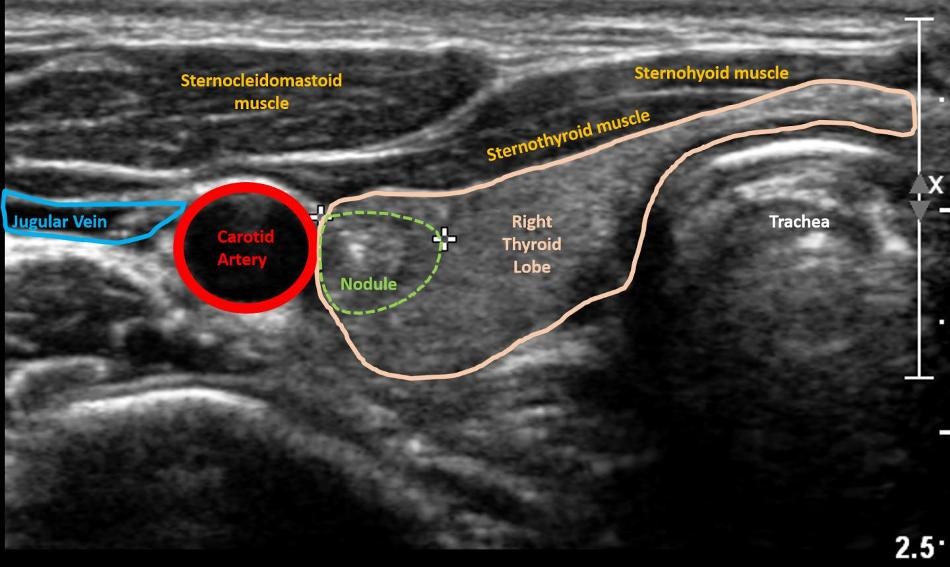Oct 25 2019
Thyroid nodules are tiny lumps that typically form inside the thyroid gland. These nodules are extremely common in the general population and have a high prevalence of 67%.
 An ultrasound image of a thyroid nodule. (Image credit: Dr Elizabeth Cottril, Thomas Jefferson University)
An ultrasound image of a thyroid nodule. (Image credit: Dr Elizabeth Cottril, Thomas Jefferson University)
Most of the thyroid nodules are not cancerous in nature and do not cause any symptoms. But at present, only limited guidelines are available on what to do with a thyroid nodule when the cancer risk is not clear.
Now, a recent study performed by The Sidney Kimmel Cancer Center-Jefferson Health explores whether thyroid cancer can be screened initially in a fast and inexpensive manner using a new approach. This approach involves a combination of a non-invasive technique of ultrasound imaging and a Google-platform machine-learning algorithm.
Currently, ultrasounds can tell us if a nodule looks suspicious, and then the decision is made whether to do a needle biopsy or not. But fine-needle biopsies only act as a peephole, they don’t tell us the whole picture. As a result, some biopsies return inconclusive results for whether or not the nodule may be malignant, or cancerous, in other words.
Elizabeth Cottril, MD and Otolaryngologist, Thomas Jefferson University
Cottril is the clinical leader of the study.
In case the examination of the cells of a needle biopsy is not conclusive, the sample can be additionally tested through molecular diagnostics to establish the risk of malignancy. Such tests search for the presence of specific molecular markers or mutations that are linked with malignant thyroid cancers.
If high-risk mutations or markers are detected in the nodules, the thyroid can be surgically removed. But the standards for when to utilize molecular testing are still being developed. Moreover, the test is not provided in all practice settings, specifically at smaller community hospitals.
To enhance the predictive power of the first-line diagnostic ultrasound, scientists at Thomas Jefferson University investigated artificial intelligence or machine learning models created by Google.
Applications like these are being utilized in other areas. For example, machine learning is used by retail giants like Urban Outfitters to categorize the various products, thus rendering it easier for consumers to locate an item they are interested in. Machine learning is also used by Disney to annotate the products based on certain movies or characters.
In this study, the scientists integrated a machine-learning algorithm into the ultrasound images of the patients’ thyroid nodules to observe whether it can identify the unique patterns. The study has been reported in JAMA-Oto on October 24th, 2109.
“The goal of our study was to see whether automated machine learning could use image-processing technology to predict the genetic risk of thyroid nodules, compared to molecular testing,” stated Kelly Daniels, first author of the study and a fourth-year medical student at Thomas Jefferson University.
The scientists trained the machine-learning algorithm on images obtained from 121 patients. These patients underwent ultrasound-guided fine-needle biopsy with further molecular testing.
Out of 134 total lesions, 91 nodules were categorized as low risk and 43 were categorized as high-risk depending on a set of genes utilized in the molecular testing. The model or algorithm was trained using an initial set of images with known risk classifications. From this set of labeled images, the algorithm made use of machine-learning technology to identify the distinguishing patterns linked with high-risk and low-risk nodules, respectively.
These patterns were used by the algorithm to create its own set of internal parameters that can be utilized to organize upcoming sets of images; essentially, the algorithm “trained” itself on this novel task. The researchers subsequently tested the trained model on another set of unlabeled images to observe how closely it can classify low and high genetic risk thyroid nodules, when compared to the results obtained from molecular tests.
Machine learning is a low-cost and efficient tool that could help physicians arrive to a quicker decision as to how to approach an indeterminate nodule. No one has used machine learning in the field of genetic risk stratification of thyroid nodule on ultrasound.
John Eisenbrey, PhD, Associate Professor, Department of Radiology, Thomas Jefferson University
Eisenbrey is the lead author of the study.
The scientists noticed that their machine-learning algorithm performed with 90% predictive positive value and 97% specificity. This means that the ultrasound of 97% of patients who really have benign nodules will be read as “benign” by the machine-learning algorithm, and 90% of “positive” or malignant nodules will be classified as truly positive by the same algorithm.
The high specificity suggests a low rate of false positives, implying that if the machine-learning algorithm reads a nodule as “malignant,” it is more likely to be positively malignant. The algorithm’s overall precision was 77.4%.
“This was such an important collaboration of surgeons and radiologists, and there’s already interest from other institutions to pool our resources. The more data we feed the algorithm, the stronger and more predictive we’d expect it to become,” added Dr Cottril.
There are so many potential applications of machine learning. In the future we’d like to make use of feature extraction, which will help us identify anatomically relevant features of high-risk nodules.
John Eisenbrey, PhD, Associate Professor, Department of Radiology, Thomas Jefferson University
Although the study was preliminary, it indicates that automated machine learning could be used as a supplementary diagnostic tool to enhance the efficiency of thyroid cancer diagnoses. After the method becomes more powerful, it can offer additional information to patients and physicians and help them decide whether the thyroid lobe needs to be removed or not.